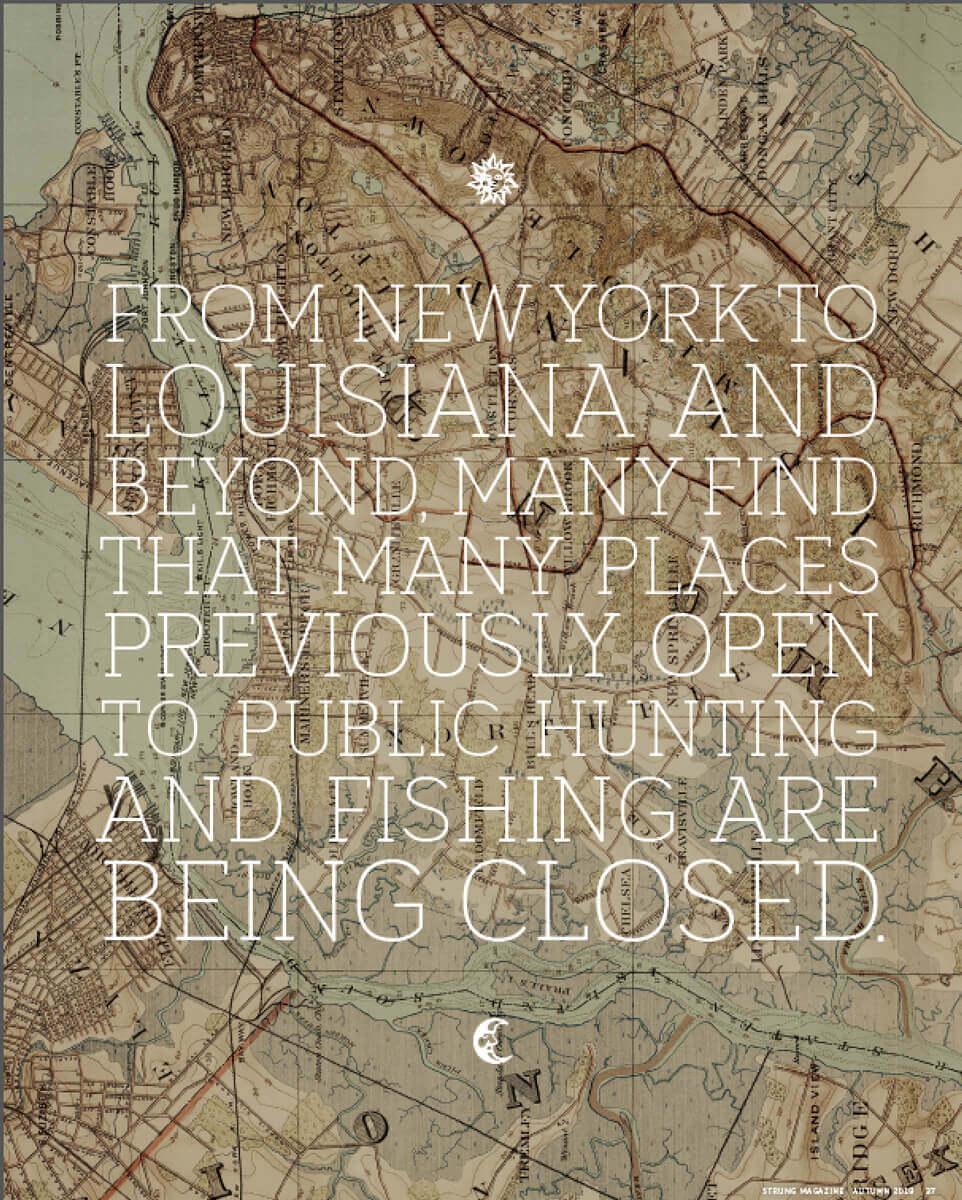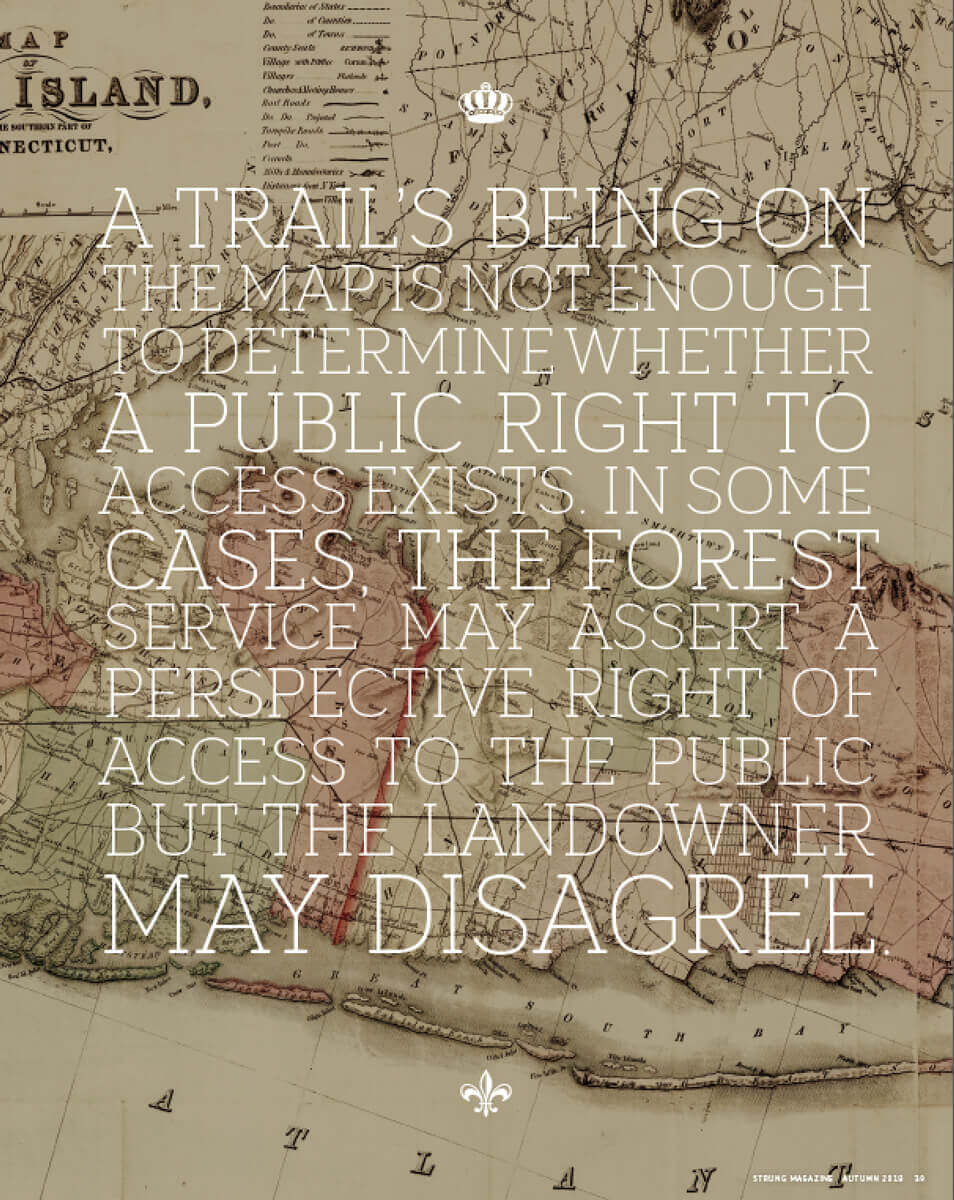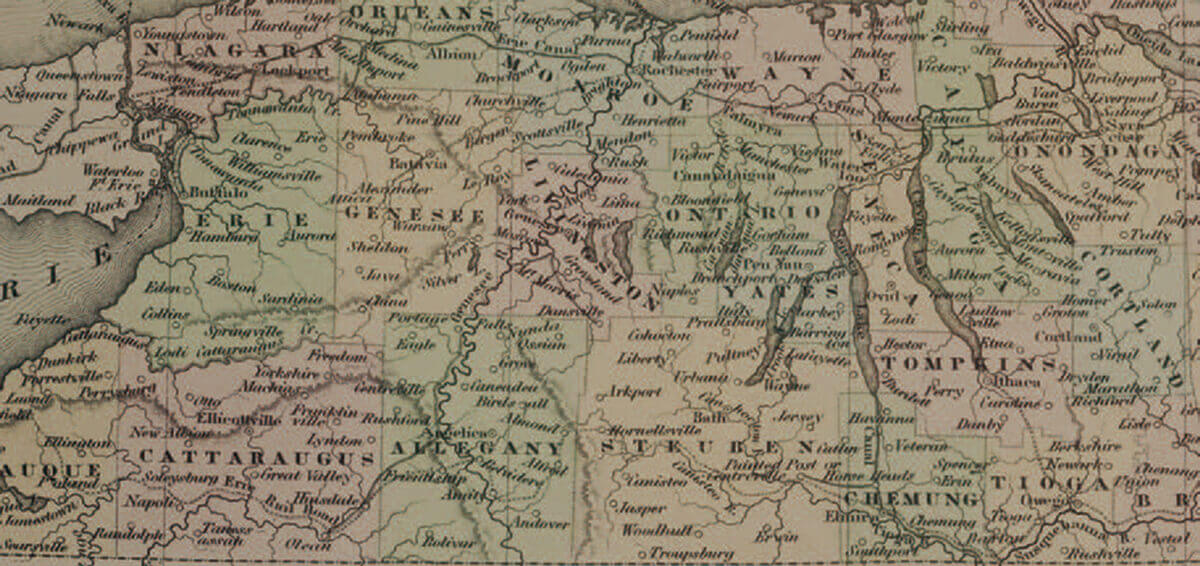From the September 2019 Issue of Strung Magazine: The Upland Issue
It was a beautiful day in the spring of 2012 when small business owner and fly angler Dargan Coggeshall headed to the river to clear his head. Tucking his fishing license into his pocket and his fly box into his kayak, Coggeshall entered one of Virginia’s finest waterways, Alleghany County’s Jackson River, from a public boat launch owned by the US Forest Service and managed by the Virginia Department of Game and Inland Fisheries (VDGIF) by joint agreement. Carefully keeping to a section of the river the state clearly marked as public property, Coggeshall gently released each naturalized rainbow and wild brown he caught back to its watery home. This, he told himself, would be a day to remember.
It certainly was.
Not far downstream from where Coggeshall had put in, landowners had posted a sign that warned this section of the river was in fact owned by a developer and thus private property–and no fishing was allowed. The developer claimed to possess a Crown Grant—a special deed from King George II to the original landowner, passed down to the current landowner—granting him title to the bottom of the river. An odd assertion? Not so very odd, actually, in the Commonwealth of Virginia: In 1966 a similar claim had been filed in court and successfully litigated by a landowner on the same river.
 On a previous fishing trip Coggeshall had made to this same stretch of river, he had encountered the landowner himself, who expressed in no uncertain terms the fact that Coggeshall was not permitted to fish there. At home after the confrontation, Coggeshall had immediately contacted an authority of the VDGIF, who had assured him that he had every right to fish on that stretch of river because it was indeed public property. The VDGIF sent the developer a letter later that same season in which the agency insisted that his signs were not enforceable.
On a previous fishing trip Coggeshall had made to this same stretch of river, he had encountered the landowner himself, who expressed in no uncertain terms the fact that Coggeshall was not permitted to fish there. At home after the confrontation, Coggeshall had immediately contacted an authority of the VDGIF, who had assured him that he had every right to fish on that stretch of river because it was indeed public property. The VDGIF sent the developer a letter later that same season in which the agency insisted that his signs were not enforceable.
Assured repeatedly by the agency that he was within his legal rights to fish the spot and was not trespassing, Coggeshall returned to the same spot where he’d been challenged before, where he was met by an Alleghany County Sheriff’s Deputy. The Sheriff’s Office refused to pursue criminal charges of trespassing that day; the landowner who had summoned law enforcement in the first place, however, filed civil trespassing charges against the angler.
Coggeshall contacted VDGIF in dismay, and the agency quickly referred him to the Virginia Attorney General’s Office, were personnel informed him that although from the standpoint of the Commonwealth Coggeshall had followed the law, the Attorney General’s Office only handled criminal complaints; his issue was with the landowner now and out of their hands. Coggeshall would receive no legal aid from Virginia. He was on his own.
After about two years of litigation–and, according to Coggeshall, after he had spent tens of thousands of dollars in legal fees out of his own pocket and with donations from various fishing advocacy groups–the angler found himself on the horns of a dilemma: the judge presiding over the case would not compel the Commonwealth of Virginia to come to court and assert its ownership of the river bottom–and the Commonwealth of Virginia flatly refused to be involved in the case at all. In the end and all alone, Coggeshall quite simply ran out of money and capitulated: He agreed not to return to that stretch of river in the future.
Anglers aren’t the only sportsmen being denied access to public land. From New York to Louisiana and beyond, hunters find that many places previously open to public hunting are being closed–either by local ordinances (forbidding the discharge of firearms, for example) or by private landowners.
A case in point is Montana’s rugged and remote Crazy Mountains, where for decades the Forest Service and private landowners have struggled to find a balance between the public’s right to access thousands of acres of federally owned land via Forest Service trails, and the rights of private landowners across whose property those trails fall. How did the conflict develop?
Few could have imagined that access to the Crazies would be so divisive when the federal government first gave tens of millions of acres (stretching from the Great Lakes to the Pacific Ocean) to the Northern Pacific Railway in 1864. After all, the government’s grand plan was to develop an otherwise sparsely populated, almost desolate stretch of the country. With railroads would come jobs, railroad towns, settlements, and more jobs.
The government gave away the land; the rail companies were on the hook to finance the lines. Generally speaking, the rail companies leveraged the vast tracts that they didn’t strictly need for the lines to help pay for the railroad itself: they opted either to mine the land for gold or other precious metals–or sell it off into private hands, often in enormous tracts of thousands of acres apiece. Over time some owners defaulted, and the land reverted back to or was repossessed by the federal government.
This “checkerboarding” of property ownership meant that today in the American West, sweepings tracts of public land are surrounded by sweeping tracts of private land. This is true of the Crazy Mountains, certain parts of which have become extremely difficult to access at all.
For years few paid attention to the issue of access: Using a network of trails that traversed private land and reached public land, the Forest Service accessed public property primarily for maintenance purposes or to reach remote ranger stations. Few knew about the trails, and even fewer had any reason to use them.
As recreational hunters discovered the trails, however, more of them began traversing private land to reach public hunting opportunities. Some of the deeds of land granted to the railroads read that “the land hereby conveyed” is subject “to an easement in the public for any public road heretofore laid out or established, and now existing over and across any part of the premises.” Some of the deeds contained this language–but not all of them. And who is to say what constitutes an “established” and “public road”?
Landowners whose deeds don’t have such explicit easement language–or who simply do not recognize historic Forest Service trails as the aforementioned established public roads–consider public use of trails that traverse private land as trespassing, plain and simple. Some landowners have posted signs reading “No Forest Service Access” or “No Public Access.” Others have installed chained gates to block public access to the trails. Still others have erected daunting and dangerous brush piles on the trails designed to force users to either walk through and over the pile–excellent snake habitat–or to go around the pile (off of a public trail and onto private property) and risk prosecution for trespassing. Longtime hunters and other frequent trail users complain that Forest Service signs and markers are routinely torn down.
In November 2016 licensed hunter Rob Gregoire used Forest Service trail #115 in the Crazies to hunt for elk on federal lands. Before his hunt Gregoire spoke directly to Yellowstone District Ranger Alex Sienkiewicz in his office, who told him that landowners had called law enforcement on Sienkiewicz himself while he was on trail #115 on official business. Nevertheless, Gregoire reports, Sienkiewicz assured him that the Forest Service considered the trail in question to be federal property and thus open to the public.
This “checkerboarding” of property ownership
meant that today in the American West,
sweepings tracts of public land are surrounded by
sweeping tracts of private land.
This is true of the Crazy Mountains,
certain parts of which have become
extremely difficult to access at all.
Naturally Gregoire was unpleasantly surprised when, after his hunt, he exited the property on trail #115 and found a Sweet Grass Sheriff’s Deputy waiting to issue him a ticket. Gregoire was subsequently charged with criminal trespassing.
So what is a Forest Service trail–open to the public–and what isn’t? Unfortunately, that is a matter of considerable debate in Montana.
“The fact that a historic trail is shown on Forest Service maps is an important piece of information but does not always paint an accurate picture of legal status,” says Marna Daley, Public Affairs Officer for the Custer Gallatin National Forest, which encompasses the Crazy Mountains. A trail’s being on the map is not enough to determine whether a public right to access exists. In some cases, the Forest Service may assert a prescriptive right of access to the public, but the landowner may disagree. Continues Daley, “We believe working respectfully toward collaborative solutions that address landowner and stakeholder interests–including hunters and anglers–is always the best approach when possible.”
 Many public access advocates are dissatisfied with the official response to access disputes. Kathryn QannaYahu, a hunter, angler, and founder of Enhancing Montana’s Wildlife & Habitat who has spent many hundreds of hours carefully documenting public access disputes in the area, argues that “if the Forest Service doesn’t step up and do its job in the Crazy Mountains, our access to these public lands will be extinguished.” John Sullivan, chairman of the Montana Chapter of Backcountry Hunters and Anglers, agrees. “These trails are public. Forest Service leadership knows this. Yet certain individuals with the Service have chosen to ignore the facts and turn their backs on the public. We have no intention of standing idly by while this faction engages in the very behavior it has deemed irresponsible.”
Many public access advocates are dissatisfied with the official response to access disputes. Kathryn QannaYahu, a hunter, angler, and founder of Enhancing Montana’s Wildlife & Habitat who has spent many hundreds of hours carefully documenting public access disputes in the area, argues that “if the Forest Service doesn’t step up and do its job in the Crazy Mountains, our access to these public lands will be extinguished.” John Sullivan, chairman of the Montana Chapter of Backcountry Hunters and Anglers, agrees. “These trails are public. Forest Service leadership knows this. Yet certain individuals with the Service have chosen to ignore the facts and turn their backs on the public. We have no intention of standing idly by while this faction engages in the very behavior it has deemed irresponsible.”
On June 10, 2019, a coalition of nonprofit advocacy groups–Friends of the Crazy Mountains, the Montana Chapter of Backcountry Hunters and Anglers, Enhancing Montana’s Wildlife and Habitat, and Skyline Sportsmen’s Association–filed a lawsuit in federal court charging that the Forest Service has failed in its duty to protect and defend public easement interests on several trails in the Crazy Mountains, including the trail that landed Rob Gregoire in hot water.
Requests by the author for interviews with or statements from area landowners have gone unanswered.
And the rest of the story? Rob Gregoire agreed to settle the case against him and avoid prosecution by making a $500 donation to the Sweet Grass Community Foundation. In exchange for the donation–and barring any further legal infractions for a year–the matter was dropped. And yet the conflict between sportsmen and landowners in the Crazy Mountains rages on.
So–to access or not to access? It’s hard to say. On the one hand, sportsmen should vigorously defend public access to public land. On the other hand, hunting or fishing on disputed land is stepping into a potential legal quagmire. The property laws vary widely from state to state and sportsmen must remember that inadvertent trespassers are still trespassing.
On the basis of the evidence of numerous access and use cases I’ve researched in several states, I can say one thing with authority: If you wander into a property dispute and find yourself hauled into court, it’s highly unlikely that anyone is coming to help you–least of all the state or federal agencies charged with protecting public access to public land. Should you encounter a disgruntled landowner who is convinced you’re trespassing and elects to press charges, you’ll most likely be on your own.
Before proceeding afield, carefully research areas you intend to hunt or fish. Don’t rely solely on message boards or social media posts from well meaning but often uninformed fellow sportsmen. You’re protected from legal action when you hunt and fish legally in designated state and federal parks. But the historic trails and the contested river bottoms that get you there? For now, sportsmen, landowners, and state and federal authorities continue to grapple with thorny questions of ownership and access.
Bio: The author of two fly fishing guidebooks, Beau Beasley is an award-winning investigative outdoor writer who has tackled such thorny issues as saltwater species management and public access/use conflicts. He is also the director of the Virginia Fly Fishing & Wine Festival and the Texas Fly Fishing & Brew Festival.
Read more insightful features in the pages of Strung Magazine



